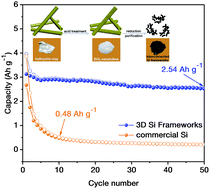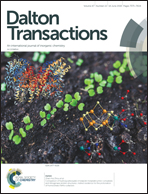Three-dimensionally interconnected Si frameworks derived from natural halloysite clay: a high-capacity anode material for lithium-ion batteries†
Abstract
On account of its high theoretical capacity, silicon (Si) has been regarded as a promising anode material for Li-ion batteries. Extracting Si content from earth-abundant and low-cost aluminosilicate minerals, rather than from artificial silica (SiO2) precursors, is a more favorable and practical method for the large-scale application of Si anodes. In this work, three-dimensionally interconnected (3D-interconnected) Si frameworks with a branch diameter of ∼15 nm are prepared by the reduction of amorphous SiO2 nanotubes derived from natural halloysite clay. Benefiting from their nanostructure, the as-prepared 3D-interconnected Si frameworks yield high reversible capacities of 2.54 A h g−1 at 0.1 A g−1 after 50 cycles, 1.87 A h g−1 at 0.5 A g−1 after 200 cycles, and 0.97 A h g−1 at 2 A g−1 after a long-term charge–discharge process of 500 cycles, remarkably outperforming the commercial Si material. Further, when the as-prepared Si frameworks and commercial LiCoO2 cathodes are paired in full cells, a high anode capacity of 0.98 A h g−1 is achieved after 100 cycles of rapid charge/discharge at 2 A g−1. This work provides a new strategy for the synthesis of high-capacity Si anodes derived from natural aluminosilicate clay.



 Please wait while we load your content...
Please wait while we load your content...